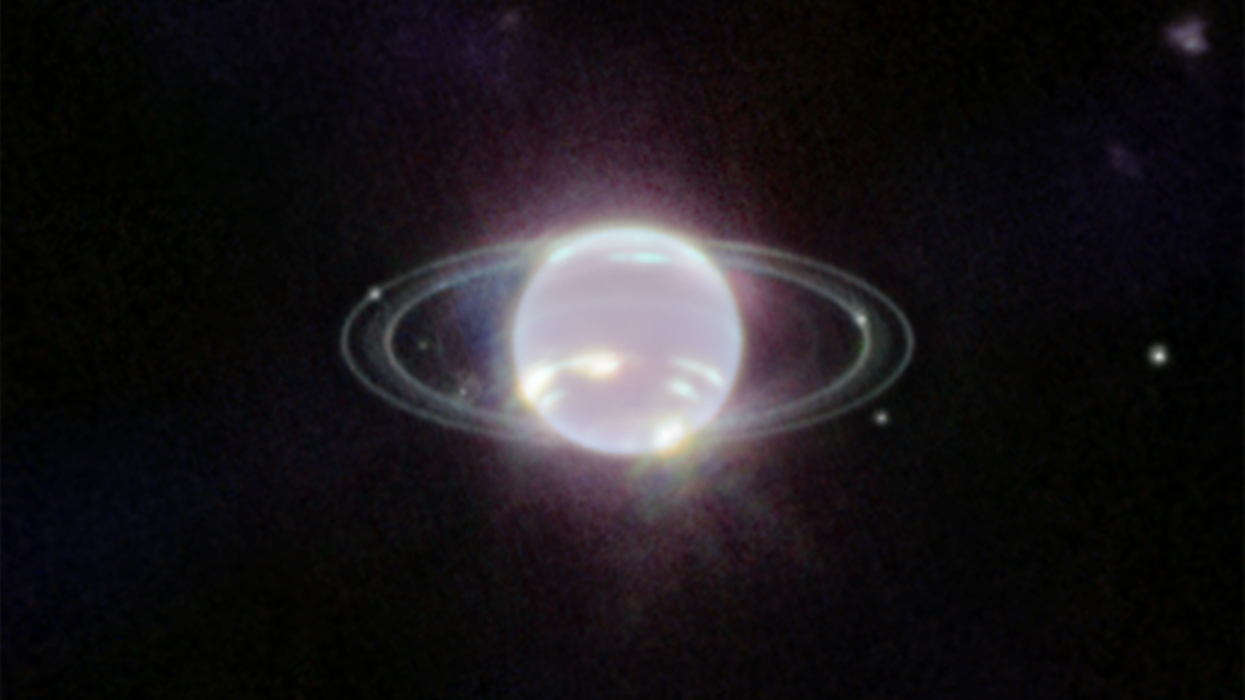
NASA

Since the first release of its full-color images and spectroscopic data on July 12, 2022, NASA's $10 billion James Webb Space Telescope set its sights on distant stars, nebulae and colorful galaxies far afield. On Wednesday, it provided a clearer look at a celestial body with which many are familiar but some might not readily recognize.
NASA noted that this is the clearest view of Neptune's rings since the spacecraft Voyager 2 flew 3,408 miles above the planet's north pole 33 years ago. It also provides a good look at the planet's fainter dust bands.
\u201cHey Neptune. Did you ring? \ud83d\udc4b\n\nWebb\u2019s latest image is the clearest look at Neptune's rings in 30+ years, and our first time seeing them in infrared light. Take in Webb's ghostly, ethereal views of the planet and its dust bands, rings and moons: https://t.co/Jd09henF1F #IAC2022\u201d— NASA Webb Telescope (@NASA Webb Telescope) 1663762078
Whereas previous images have depicted Neptune as blue, Webb's Near-Infrared Camera (NIRCam) captures images of objects in the near-infrared range from 0.6 to 5 microns. Since the methane gas in the planet's atmosphere absorbs red and infrared light, NASA reported the light appears dark with the exception to those spots where high-altitude clouds are present.
The NIRCam is capable of detecting light from the earliest stars and galaxies in the process of formation as well as the population of stars in nearby galaxies.
\u201cIn visible light, Neptune appears blue due to small amounts of methane gas in its atmosphere. Webb\u2019s NIRCam instrument instead observed Neptune at near-infrared wavelengths, so Neptune doesn\u2019t look so blue!\u201d— NASA Webb Telescope (@NASA Webb Telescope) 1663762078
Heidi Hammel, a Neptune system expert and interdisciplinary scientist for Webb, noted, "It has been three decades since we last saw these faint, dusty rings, and this is the first time we've seen them in the infrared."
Some of these rings have been named. In order from those nearest the planet then proceeding outward, they are: Galle, Leverrier, Lassell, Arago, and Adams.
In addition to dusty bands and rings, Webb's image captured the planet's 14 known moons: Galatea, Naiad, Thalassa, Despina, Proteus, Larissa, and Triton.
In the zoomed-out image (below), Triton appears to be a spiky star. Triton, which is bigger than Pluto, appears brighter because it is covered in ice and the ice reflects light.
At the top of the image, just out of view, is the planet's north pole. Its south pole, clearly visible, has about its vortex a continuous band of high-altitude clouds.
Neptune, the eighth planet, was discovered in 1846. Although imperceptible to the naked eye, astronomers were able to track down the ice giant with a telescope, guided by mathematic calculations related to observed disruptions in the orbit of Uranus.
\u201cLet\u2019s zoom out and get the big picture! Some quick Neptune facts:\n\ud83d\udccd Far out - 30x farther from the Sun than Earth\n\ud83d\udd76\ufe0f Hello darkness my old friend - Neptune doesn\u2019t get much Sun, so high noon would be like a dim twilight on Earth.\n\ud83e\udd76 Ice giant. Brr.\u201d— NASA Webb Telescope (@NASA Webb Telescope) 1663762078
Although several astronomers had previously observed Neptune, they had not recognized it to be a planet. Johann Gottfried Galle was the first to observe the new planet with the Fraunhofer telescope at the Berlin Observatory on September 23, 1846. He had utilized Urbain Jean-Joseph Le Verrier's calculations, who like John Couch Adams in England, had calculated the position of the planet.
Per Verrier's suggestion, the planet was named after the mythological Roman god of the sea.
Neptune is roughly four times wider than Earth. To illustrate the difference, NASA likened Earth to a nickel (not to say it is flat), and Neptune to a baseball.
It takes Neptune 165 Earth years to complete its orbit around the sun, and completes its rotation every 16 hours.
Of the giant planets, Neptune is the densest. It has a relatively small rocky core, lacks a solid surface, and is 80% comprised of a hot, dense slurry of water, methane, and ammonia. Its atmosphere is majoritively comprised of molecular hydrogen, atomic helium and methane.
Earlier this month, NASA released images taken by the Webb of the Tarantula Nebula star-forming region. The Tarantula Nebula resides 161,000 light-years away in the Large Magellanic Cloud galaxy.
\u201cThis Webb caught a giant space tarantula! \ud83d\udd78\ufe0f \r\rTake a moment to stare into thousands of never-before-seen young stars in the Tarantula Nebula. @NASAWebb reveals details of the structure and composition of the nebula, as well as background galaxies: https://t.co/DZePgDpPEH\u201d— NASA (@NASA) 1662475795
In August, the Phantom Galaxy, M74, was shown in infrared. This spiral galaxy is 32 million light-years away in the constellation Pisces. According to NASA, it lies almost face-on to Earth.
\u201cFeast your eyes on the beautiful spiral structure of the Phantom Galaxy, M74, as seen by Webb in the mid-infrared. Delicate filaments of dust and gas wind outwards from the center of the galaxy, which has a ring of star formation around its nucleus. https://t.co/pPVvxsC6KA\u201d— NASA Webb Telescope (@NASA Webb Telescope) 1661868061
Images of Jupiter in infrared, highlighting its "Great Red Spot" were also shared in August.
\u201cCheck out the bright waves, swirls, and vortices in Jupiter\u2019s atmosphere \u2014 as well as the dark ring system, one million times fainter than the planet! Two moons of Jupiter, including one that\u2019s only about 12 miles (20 km) across, are on the left.\u201d— NASA Webb Telescope (@NASA Webb Telescope) 1661170468
"Cosmic Cliffs" was among the first images taken by Webb to be shared in July. This image highlights the edge of a gaseous cavity with a star-forming region called NGC 3324 in the Carina Nebula.
\u201c\ud83c\udf1f A star is born!\n \nBehind the curtain of dust and gas in these \u201cCosmic Cliffs\u201d are previously hidden baby stars, now uncovered by Webb. We know \u2014 this is a show-stopper. Just take a second to admire the Carina Nebula in all its glory: https://t.co/tlougFWg8B #UnfoldTheUniverse\u201d— NASA Webb Telescope (@NASA Webb Telescope) 1657639238